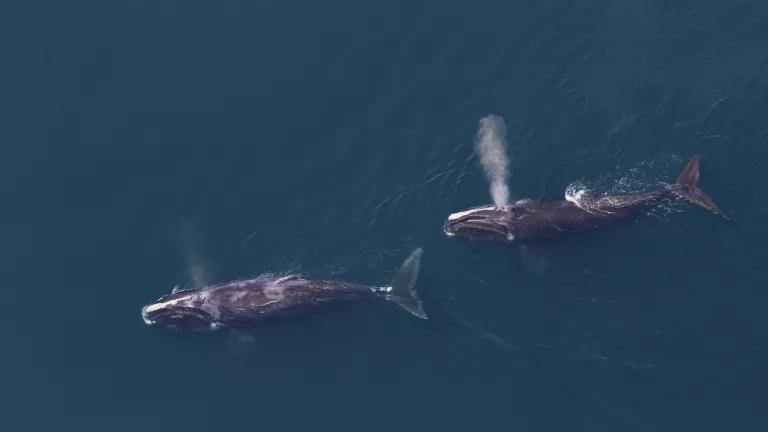Responsible Offshore Wind Requires Smart Vessel Speeds
Adopting a 10-knot speed limit for all offshore wind project vessels will help ensure this new American industry advances with strong protections for whales and sea turtles.

Offshore wind is taking off along America's shores. Strong vessel speed limits for project vessels will help protect endangered marine life.
We need offshore wind, and we need to do it right. Offshore wind is critical to reaching our national climate goals, promising healthier air and creating thousands of well-paying clean energy jobs. But as we fight climate change, we can and must avoid, minimize, and mitigate threats to vulnerable ocean life. With the administration planning to potentially complete review of at least 16 offshore wind projects and hold five additional offshore wind lease sales by 2025, it’s clear that we need to incorporate smart mitigation measures for potential impacts right from the start.
One necessary element of responsible offshore wind development is the establishment of strong vessel speed restrictions. Slower speeds significantly reduce the chance of death and serious injury to whales and sea turtles from vessel strikes. Visual monitoring is insufficient; even well-trained observers can experience difficulty spotting whales and sea turtles, and even more so when aboard a moving vessel.
The risk of vessel strikes is not unique to offshore wind vessels, and offshore wind will be a critical part of fighting the climate crisis, which is itself a major threat to marine ecosystems. Nevertheless, the offshore wind industry should do everything it can to avoid adding to the already substantial risks to endangered and threatened species. While offshore wind-related activities are only one component of overall vessel traffic, it still generates an additional risk of vessel strikes that should be mitigated together with the other vessels. Setting a strong speed limit also helps insulate industry from delays that could occur from accidentally killing or injuring an endangered species.
In the case of the highly endangered North Atlantic right whale, even a single vessel strike from any boat operating anywhere on the water has major ramifications for the survival of the species. With fewer than 340 individuals remaining, the North Atlantic right whale is in precarious straits. The species is rapidly declining due primarily to vessel strikes and fishing gear entanglements, and are subject to a multitude of additional threats, including underwater noise pollution and malnourishment, all while fighting to adapt to climate change. With the species simply unable to withstand further loss or disturbance, the right whale crisis is not a problem caused by the offshore wind industry, but it is one the industry must face.
Adopting a 10-knot speed limit for all offshore wind project vessels – regardless of size, function, or time of year – will help ensure this new American industry advances with requirements in place to protect marine life. The offshore wind industry is investing in promising technologies to detect and avoid whales in real-time but, until technology is proven to be successful by independent and peer-reviewed scientific study, it is safest for boats to keep to 10 knots or less.
Some states and developers are taking these concerns to heart.
- The California Coastal Commission is requiring lessees to adhere to a 10-knot vessel speed limit during their site assessment activities to develop projects offshore California and has signaled they will require the same during future development activities. Developers have spoken in support of the Commission’s site assessment and characterization activity requirements. American Clean Power Association’s Varner Seaman stated, “We accept these costs and we accept these conditions with an understanding that offshore wind needs to be responsibly developed.”
- The South Fork Wind project, on target to supply New York by the end of 2023 with enough renewable power for 70,000 homes, now includes enhanced protections for the North Atlantic right whale. A recent conservation agreement between South Fork Wind (a joint venture developed by Ørsted and Eversource), NRDC, the National Wildlife Federation, and the Conservation Law Foundation—expands beyond the company’s formal Record of Decision with the U.S. government to incorporate measures that further safeguard the health of the North Atlantic right whale. Key among these is a 10-knot speed limit for all project-related vessels throughout the project’s lifetime unless an equally effective, scientifically-proven adaptive speed management plan is in place. South Fork Wind will now serve as a pilot program for these more rigorous right whale provisions, providing enhanced protective measures at the start of this new U.S. industry.
We also need action from the federal government to reinforce state and developer commitments, and further guard against potential offshore wind impacts so that this industry can get off to a strong start.
One hopeful note is an important multi-agency initiative to increase protections for the critically endangered North Atlantic right whale during offshore wind activities. Incorporating a North Atlantic right whale strategy from day one of commercial-scale offshore wind development in U.S. waters showcases the Biden administration’s commitments to fight climate and stem biodiversity loss. Turbine construction for the nation’s first commercial-scale projects begins offshore New England in early 2023 and we have a unique, but brief, period before steel goes in the water to layer in further necessary protections for these projects and to shape future ones.
To reach a sustainable renewable energy future we need offshore wind to succeed – and at a far greater scale. This requires advancing this new American industry in a smart way that protects our valuable and vulnerable ocean life. Moving ahead with proactive, protective measures like a 10-knot speed limit, based on the best available science and designed to learn as we go, is essential to building durable support for responsibly developed offshore wind as a successful climate mitigation strategy.




